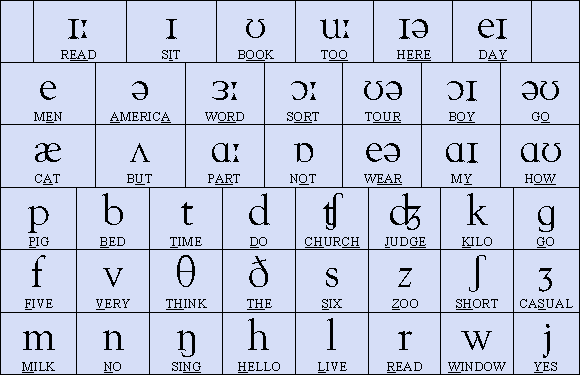Kanji - my nemisis!
One of the most difficult parts of learning Japanese is getting to grips with Kanji.
The other two systems of writing (Hiragana and Katakana) are more like English in that each symbol represents a sound. So each time you see the symbol you pronounce the sound connected to it.
In fact, they're simpler than the English alphabet as each symbol only has one sound no matter where it appears in a word. In contrast, the sounds of letters in the English alphabet are depending on where the letter appears in a word and the other letters around it.
Consequently many English learners are familiar with this chart, which lists the sounds rather than the letters of English. These are used in most dictionaries to tell you how to pronounce the word (although if you're a native speaker and not a teacher you may never have noticed them)

 Kanji are not so much 'letters' but symbols derived from pictures which have a connected meaning rather than sound. Kanji normally have at least two readings and sometimes many more, so even if you know what the symbol means you might not make the right sound!
Kanji are not so much 'letters' but symbols derived from pictures which have a connected meaning rather than sound. Kanji normally have at least two readings and sometimes many more, so even if you know what the symbol means you might not make the right sound!
The usual method of learning Kanji is through making little flashcards and basically memorising the image, meaning and different pronunciations.
This didn't work too well for me, so i've started another method. It's just as long winded (if not more so!) and still relies on memory, but uses a different type of memory.
It's often said that people who are able to memorise massive amounts of information do so by making stories. I never really understood this and thought adding more information would surely lessen your chances of remembering. I.e if I'm trying to remember a shopping list then I thought it was easier to remember
Eggs
Brown bread
Butter
Coffee
Than...
My friend (eggs) benedict has a brown head (bread) he's fine, so is his girlfriend but her (butter) mother is a little coughy (coffee).
It's precisely this kind of elaborate story which I'm now using to memorise Kanji. The system starts with simple images from the the Kanji then builds more detailed stories as the Kanji become more detailed.
I'll give you a few examples...
This means 'child' as it looks a bit like a child with outstretched arms
This is 'complete', easy to remember as the child is incomplete, you need to complete it.
A child waving its arms at the sight of the dentist's 'hook' - it means 'cavity'
A child learns it's first 'characters/letters' under the 'roof' of it's home.
These are some of the early ones but they get more complex and the stories get stranger. It seems strange but sometimes the strangest stories are the easiest to remember.
This means 'prison' and the story I use is about a pack of wild dogs going to visit their cousin a domestic dog in prison and talking through an intercom.
I can now recognise a lot more Kanji and understand their meaning a lot better, but I still don't know how to pronounce most of them in Japanese!
The technique comes from a book called 'Remembering the Kanji' and has been adapted on a website called 'Reviewing the Kanji'. The website allows learners to add their own stories and choose popular ones that have already been added. Using this technique, you need to associate the English meaning to around 2,000 of the most widely used Kanji, before going back and adding the Japanese pronunciation and looking at common Kanji compounds.
I've learned about 450 so far, so only about 1600 to go....then learning the Japanese pronunciation, and common compounds.....*sigh*